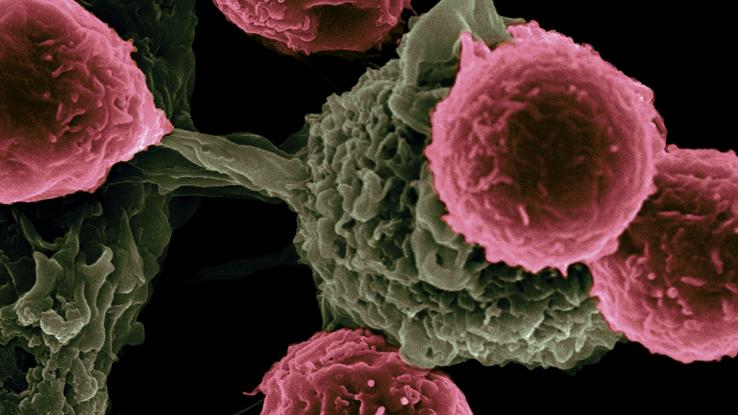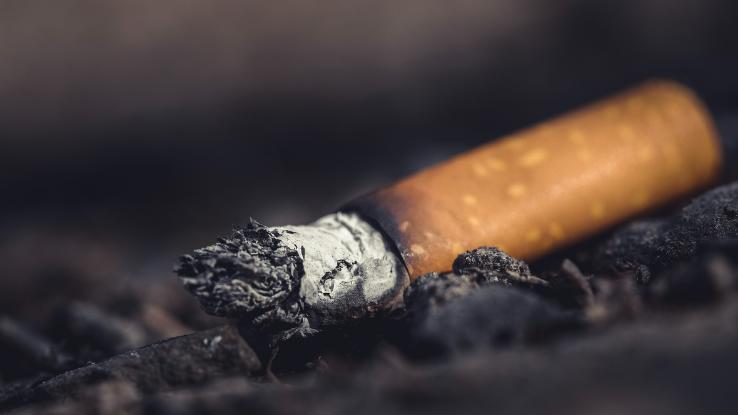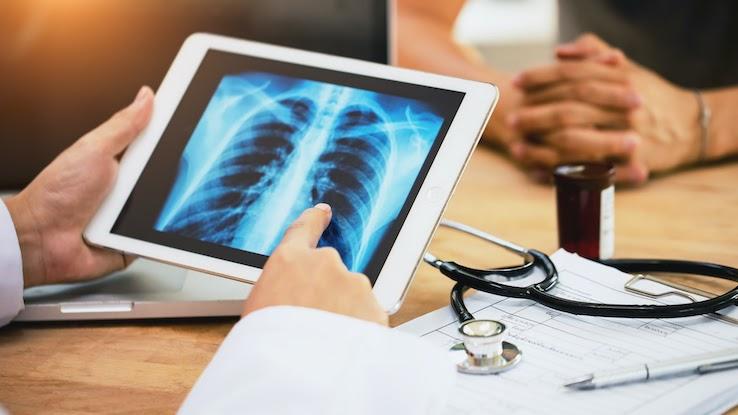Everything You Need to Know About Lung Cancer

Lung cancer is the second most common cancer in the United States and is the foremost cause of cancer-related deaths, resulting in an estimated 235,000 new diagnoses and 131,000 deaths in 2021. Most cases of lung cancer are associated with smoking; however, non-smokers can also develop the disease. This type of cancer is also the leading cause of cancer deaths in the U.S., accounting for 25% of all deaths due to cancer — more than colon, breast and prostate cancers combined.
Lung cancer occurs most often in older people and occurs more frequently in men than women. Over 70% of cases of lung cancer are caused by smoking, and smoking remains the single biggest risk factor for developing the disease. The number of new diagnoses of lung cancer continues to decrease, which is largely attributable to the decrease in smoking.
Because lung cancer has such prominent effects on the overall health of the country, it’s important to understand the basics of this condition, including the ways it manifests and how doctors diagnose and treat it.
Types of Lung Cancer
There are two broad types of lung cancer: non-small cell lung cancer (NSCLC) and small cell lung cancer (SCLC).
NSCLC is much more common than SCLC. This type of cancer accounts for about 80–85% of all lung cancer cases. NSCLC can be subdivided according to the type of cells that are present and causing the cancer. The most common subtypes are:
- Adenocarcinoma: This type of cancer begins in the mucus-producing cells in the lungs. It’s the most common type of lung cancer in the United States and has been linked to smoking, but it’s also the most common type of lung cancer to affect non-smokers. It usually develops slowly, though it is possible for this type to develop quickly. When it spreads to other areas of a person’s body, it often spreads to the brain. It can also metastasize (spread) to the lymph nodes, the liver, the adrenal glands and bone.
- Squamous cell carcinoma, also called epidermoid carcinoma: This type of cancer begins in the epithelial cells that line the air passages leading to the lungs. If left untreated, this cancer can metastasize to the lymph nodes, adrenal glands, liver, bones and brain. It accounts for about 25% of all lung cancers in the United States. The most common cause of squamous cell carcinoma is smoking.
- Large cell carcinoma: This type of cancer is responsible for about 10–20% of lung cancers. Large cell carcinomas include all lung cancers that cannot be classified as the two types of cancer listed above.
SCLC accounts for about 10–15% of all lung cancers. As the name implies, the cells are smaller than typical cancer cells. This type of cancer tends to spread rapidly and often carries a poor prognosis.
Mesothelioma is another type of lung cancer. It affects the outer membrane surrounding the lungs and affects those who have had extensive exposure to asbestos — a mineral that releases microscopic particles and fibers that can lodge in a person’s lung tissue and damage it. It primarily affects men who are over 60 years of age who spent many years working in industrial jobs that exposed them to asbestos, such as those in mines or shipyards. This is a very rare form of cancer, only affecting 2,500–3,000 people per year, and it’s usually diagnosed at a late stage.
Causes and Symptoms of Lung Cancer

The leading cause of lung cancer is smoking. Carcinogens (cancer-causing chemicals) in cigarettes damage the cells that line the lungs. However, it’s also possible for those who have never smoked to develop lung cancer. The cause of the cancer is often unknown in people who’ve never used tobacco.
Other risk factors associated with the development of lung cancer are:
- Age: Lung cancers are more common with increasing age. Most people diagnosed with lung cancer are over the age of 65.
- Family history of lung cancer: If you have a first-degree relative, meaning a parent or sibling, with lung cancer, you’re more likely to develop the condition too.
- Second-hand smoke: There’s evidence that prolonged exposure to tobacco smoke, even if you’re not the person smoking, is associated with an increased risk of lung cancer.
- Exposure to chemicals: Radon, uranium, arsenic, silica, vinyl chloride, coal products, mustard gas and diesel fumes may all raise your risk of lung cancer.
- Air pollution: People living in cities are at a greater risk of developing lung cancer due to air pollution.
Typically, and especially in early stages, lung cancer has no symptoms. In later stages, symptoms include:
- A new cough or changes to an existing “smoker’s cough”
- Hemoptysis (coughing up blood)
- Wheezing
- Dyspnea (shortness of breath)
- Hoarseness
- Chest pain
- Unintentional weight loss
- Headache
- Bone pain
Anyone who experiences these symptoms or who is having trouble quitting smoking should see their doctor and discuss these concerns. Your healthcare professional can provide you with resources and treatments that can help you stop using tobacco.
Diagnosing Lung Cancer

Diagnosing lung cancer involves your doctor learning about your health and behavior history, performing a physical examination, conducting imaging tests and testing tissue samples.
First, your physician will take your detailed medical history to learn about your prior medical conditions, your family health history, your symptoms suggestive of lung cancer and your lifestyle factors, such as whether you’re a smoker or you’ve been exposed to harmful chemicals. They’ll also perform a physical exam to assess vital signs, such as your oxygen saturation levels, and do an examination of your chest, paying particular attention to listening to the sounds your chest makes.
One of the first investigations for lung cancer is a plain chest X-ray, which may show signs of cancer. However, an X-ray image cannot provide a definitive diagnosis. Further imaging you need to undergo may include a computed tomography (CT) scan, which can show more definitive evidence of lung cancer. A CT scan may also provide information on whether the cancer has spread to other tissues in your body. A positive electron tomography (PET) scan may also be performed to determine the locations in your lungs and body where there might be active cancer cells.
For a definitive diagnosis, your doctor may take a small sample of tissue in a process called a biopsy. A laboratory will study the tissue to see if cancer cells are present in it. If your doctor suspects there’s cancer in one of the larger airways of your lungs, they may perform a bronchoscopy to sample the tissue. During this procedure, a flexible camera is inserted into your airways to directly view any abnormalities. A small sample of tissue from abnormal areas is taken and sent to the laboratory for analysis.
If your doctor cannot assess the cancer via bronchoscopy, but they suspect the cancer has spread to a lymph node, they may perform a needle biopsy from that lymph node. In other cases a sample of any fluid around your lung may be taken in a procedure called a thoracocentesis, or “pleural tap.” A biopsy enables your healthcare team to tell what tissue type of cancer it is, which can help them determine your treatment.
Blood tests may be performed to check how well your bodily systems are working and may help guide your doctor to the forms of treatment that’ll be most effective.
Once your doctor has performed all of the necessary diagnostic tests, your healthcare team will be able to tell the type and stage of your lung cancer. Staging is a measure of how big the tumor is and whether it has spread to other tissues, such as your lymph nodes or other organs. Staging will determine what treatment will be most suitable.
You may also undergo other tests to assess your fitness for certain types of treatment. These may include spirometry, which is a specialized test of the function of your lungs. It can tell the doctor how well your lungs are able to hold and expel air and how effectively they’re able to exchange oxygen.
Treatment for Lung Cancer
Treatment for lung cancer will depend upon a number of factors, including the stage of the cancer at the time of diagnosis and the type of cancer you’re diagnosed with.
Small cell carcinoma is usually treated with chemotherapy and radiation. This is effective. However, this is also a difficult type of cancer to eradicate completely and it commonly recurs.
Non-small cell carcinoma can be treated with surgical removal of tumors and with chemotherapy and radiation. This type of cancer can be completely removed, but the success of the treatment depends upon the stage of the cancer at the time of diagnosis. Sometimes the goal of treatment is not to completely cure the cancer, but to extend the patient’s life.
Surgery
A thoracic oncologist, which is a surgeon who specializes in lung cancer treatment, may use one of several surgical techniques to remove a lung tumor and nearby lymph nodes. A lobectomy involves removing the affected lobe of the lung and is often effective in treating tumors of all sizes. The surgeon may also perform a wedge resection to remove a section of tissue that includes the tumor, and a segmental resection may be necessary to remove a larger portion of the lobe. In some cases, the surgeon may perform a pneumonectomy, which is surgery to remove the entire lung.
Chemotherapy
Chemotherapy is the use of toxic drugs to kill lung cancer cells. An oncologist generally delivers the drugs intravenously (IV) over the course of several weeks or months. Side effects may include nausea, vomiting, hair loss, fatigue, diarrhea and loss of appetite. Doctors often use chemotherapy before surgery to shrink cancer cells or facilitate their removal, and they may use it after surgery to kill any remaining cancer cells.
Radiotherapy
Radiation therapy involves directing radiation beams such as X-rays at cancer tissue from inside or outside your body. Doctors may use this treatment as a first course of action in patients who cannot undergo surgery, to kill remaining cancer cells after surgery, or to relieve symptoms in patients with advanced-stage lung cancer.
Targeted therapy
This treatment uses drugs to target certain genetic abnormalities in cancer cells. One example is Bevacizumab, which prevents the tumor from creating its own blood supply and is used in the treatment of NSCLC. Use of these targeted therapies depends upon which genetic mutations your type of cancer has.
Immunotherapy
Immunotherapy uses specific drugs to target parts of your own immune system. They work to make the cancer cells more visible to your own immune system, and that can boost your body’s immune response against these rogue cells.
Lung cancer often doesn’t have a good prognosis. The prognosis will depend upon a number of things, including the type of cancer, the size of the tumor, the stage of the cancer at detection, the treatment doctors use and the patient’s overall health. The American Lung Association estimates an overall five-year survival rate of around 18–19% for patients with lung cancer, and more than half of people diagnosed with lung cancer die within a year.
It’s worth remembering that there are numerous treatments available to both prolong your life and to provide relief from symptoms of lung cancer. The most important thing you can do to avoid developing lung cancer is to not smoke, so it’s important to seek aid in stopping smoking if you are someone who smokes, and to be vigilant for signs and symptoms of lung cancer to aid in early detection.
Resource Links:
https://www.lung.org/lung-health-diseases/lung-disease-lookup/lung-cancer
https://www.cdc.gov/cancer/lung/
https://medlineplus.gov/lungcancer.html
https://www.nhs.uk/conditions/lung-cancer/
https://www.cancer.org/cancer/lung-cancer.html
https://www.cancerresearchuk.org/about-cancer/lung-cancer
https://bestpractice.bmj.com/topics/en-gb/1082
https://bestpractice.bmj.com/topics/en-gb/1081
https://www.mayoclinic.org/diseases-conditions/lung-cancer/symptoms-causes/syc-20374620





